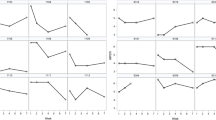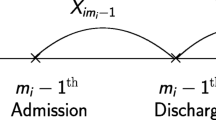Abstract
To study the effect of methadone treatment in reducing multiple drug uses while controlling for their joint dependency and non-random dropout, we propose a bivariate binary model with a separate informative dropout (ID) model. In the model, the logit of the probabilities of each type of drug-use and dropout indicator as well as the log of the odds ratio of both drug-uses are linear in some covariates and outcomes. The model allows the evaluation of the joint probabilities of bivariate outcomes. To account for the heterogeneity of drug use across patients, the model is further extended to incorporate mixture and random effects. Parameter estimation is conducted using a Bayesian approach and is demonstrated using a methadone treatment data. A simulation experiment is conducted to evaluate the effect of including an ID modeling to parameters in the outcome models.
Similar content being viewed by others
References
Alfo M, Aitkin M (2000) Random coefficient models for binary longitudinal responses with attrition. Stat Comput 10: 279–287
Azzalini A (1994) Logistic regression for autocorrelated data with application to repeated measures. Biometrika 81: 767–775
Bradlow ET, Zaslavsky AM (1999) A hierarchical latent variable model for ordinal data from a customer satisfaction survey with ‘no answer’ responses. J Am Stat Assoc 94: 43–52
Carey V, Zeger S, Diggle P (1993) Modelling multivariate binary data with alternating logistic regressions. Biometrika 80: 517–526
Chan JSK, Kuk AYC, Bell J (1997) A Likelihood approach to analysing longitudinal bivariate binary data. Biom J 39: 409–421
Chan JSK, Kuk AYC, Bell J, McGilchrist C (1998) The analysis of methadone clinic data using marginal and conditional logistic models with mixture or random effects. Aust & NZ J Stat 40: 1–10
Chan JSK, Kuk AYC, Yam HK (2005) Monte Carlo approximation through Gibbs output in generalized linear mixed models. J Multivar Anal 94: 300–312
Cowles MK, Carlin BP, Connett JE (1996) Bayesian tobit modeling of longitudinal ordinal clinical trial compliance data with nonignorable missingness. J Am Stat Asso 91: 86–98
Diggle P, Kenward MG (1994) Informative dropout in longitudinal data analysis. Appl Stat 43: 49–93
Fleiss JL (1981) Statistical methods for rates and proportions. Wiley, New York
Gelfand AE, Smith AFM (1990) Sampling-based approaches to calculating marginal densities. J Am Stat Assoc 85: 398–409
Gilks WR, Richardson S, Spiegelhalter DJ (1996) Markov chain Monte Carlo in practice. Chapman and Hall, UK
Glynn JJ, Laird NM, Rubin DB (1986) Selection modeling versus mixture modeling with nonignorable nonresponse. In: Wainer H (ed) Drawing inferences from self selected samples. Springer, New York, pp 115–142
Hastings WK (1970) Monte Carlo sampling methods using Markov Chains and their applications. Biometrika 57: 97–109
Kenward MG, Molenberghs G (1998) Likelihood based frequentist inference when data are missing at random. Stat Sci 13: 236–247
Laird NM (1988) Missing data in longitudinal studies. Stat Med 7: 305–315
Liang KY, Zeger SL (1989) A class of logistic regression models for multivariate binary time series. J Am Stat Assoc 84: 447–451
Little RJ, Rubin DB (1987) Statistical analysis with missing data. Wiley, New York
Metropolis N, Rosenbluth AW, Rosenbluth MN, Teller AH (1953) Equations of state calculations by fast computing machines. J Chem Phys 21: 1087–1091
Michiels B, Molenberghs G, Bijnens L, Vangeneugden T, Thijs H (2002) Selection models and pattern-mixture models to analyze longitudinal quality of life data subject to drop-out. Stat Med 21: 1023–1041
Molenberghs G, Michiels B, Kenward MG (1998) Pseudo-likelihood for combined selection and pattern-mixture models for incomplete data. Biom J 40: 557–572
Montmarquete C, Mahweredjian S, Houle R (2001) The determinants of university dropouts: a bivariate probability model with sample selection. Biom J 40: 557–572
Rubin DB (1976) Inference and missing data. Biometrika 63: 581–592
Schwarz G (1978) Estimating the dimension of a model. Ann Stat 6: 461–464
Smith AFM, Roberts GO (1993) Bayesian computation via the Gibbs sampler and related Markov chain Monte Carlo methods. J Roy Stat Soc Ser B 55: 3–23
Spiegelhalter D, Thomas A, Best N (2000) Bayesian inference using Gibbs sampling, Window Version, http://www.mrc-bsu.cam.ac/bugs/winbugs/contents.shtml
Wu MC, Carroll RJ (1988) Estimation and comparison of changes in the presence of informative right censoring by modeling the censoring process. Biometrics 44: 175–188
Yan J, Fine JP (2004) Estimating equations for association structures. Stat Med 23: 859–874
Zeger SL, Liang KY (1991) Feedback models for discrete and continuous time series. Statistica Sinica 1: 51–64
Zhao LP, Prentice RL, Self SG (1992) Multivariate mean parameter estimation using a partly exponential model. J Roy Stat Soc Ser B 54: 805–811
Author information
Authors and Affiliations
Corresponding author
Rights and permissions
About this article
Cite this article
Chan, J.S.K., Wan, W.Y. Bayesian approach to analysing longitudinal bivariate binary data with informative dropout. Comput Stat 26, 121–144 (2011). https://doi.org/10.1007/s00180-010-0213-5
Received:
Accepted:
Published:
Issue Date:
DOI: https://doi.org/10.1007/s00180-010-0213-5




